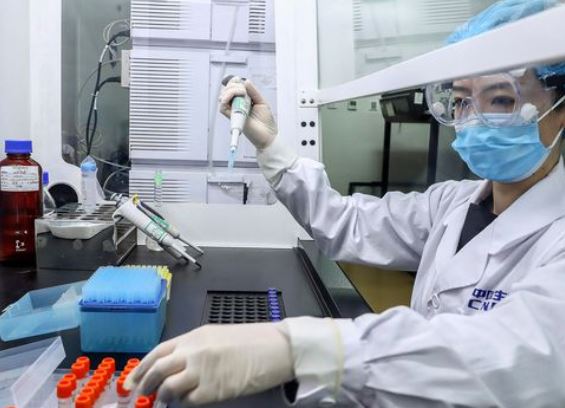Ethiopia: China has set up a vast supply chain network in Ethiopia’s new airport Cargo Terminal.
Beginning with vaccine assembling and delivery in a soccer field-sized freezer to store vials in a control room with a wall of monitors, the Chinese and Ethiopian technicians track the temperatures of every batch.
More than one million doses of China’s new Covid-19 inoculations are expected to move to this terminal this week and more are set to arrive due to a partnership between Chinese technology giant Alibaba Group Holding Ltd. and Ethiopian Airlines, said officials at the state-owned airline.
To earn the goodwill of politicians and people across the world, China’s government, state enterprises, and private companies have laid the groundwork for a vaccination push from Africa to the Middle East and Latin America. They’ve assembled a supply chain that would maintain temperature controls from the point of manufacturing through every step of distribution—and further, the “Health Silk Road,” as Beijing has called it.
What is the Health Silk Road (HSR)
The Health Silk Road (HSR) is a part of China’s Belt Road Initiative (BRI).
Mainly designed to increase its influence in the developing world and eventually as a guardian of global public health.
Beijing wanted to shape Public Health Governance since 2014 using the HSR. Due to the COVID19 pandemic, China has substantially revived its HSR project as an outreach to its partner countries.
Articles have also made a comparison between WHO’s multilateral model and China’s hub and spoke model to influence World Public Health.
The World Health Organization (WHO) enthusiastically endorsed the HSR as early as 2017.
Due to the COVID pandemic, many of China’s BRI partners are asking for debt relief and are unlikely to borrow heavily for mega infrastructure projects. Health care may be more cost-effective as outreach during the pandemic.
Why did Beijing Revive its HSR During COVID?
Wolf Warrior Diplomacy: To control the narrative about its role in the coronavirus pandemic and portray itself as a global health leader using social media and other communication channels to defend Beijing and Xi’s Government image.
Tag line: China has been “Open and Transparent” in dealing with the pandemic
Mask Diplomacy- Rushing medical supplies to all over the world. In South Asia, the PRC has donated testing kits, personal protective equipment, masks, and medical supplies to Bangladesh, the Maldives, Nepal, Pakistan, and Sri Lanka. It has also extended a $500 million loan to Sri Lanka and sent a team of experts to Bangladesh to treat patients and train medical professionals in the country. In Pakistan, China is building a makeshift hospital in addition to supplying ventilators
Wolf Warrior Diplomacy in South Asia: Inflexible and Political Strings.
Health Aid: At the beginning of the pandemic in South Asia, the PRC has donated testing kits, personal protective equipment, masks, and medical supplies to Bangladesh, the Maldives, Nepal, Pakistan, and Sri Lanka. It has also extended a $500 million loan to Sri Lanka and sent a team of experts to Bangladesh to treat patients and train medical professionals in the country. In Pakistan, China is building a makeshift hospital in addition to supplying ventilators.
China in South Asia: In South Asia, the Maldives and Pakistan have sought to restructure their debt to China while Bangladesh has requested China to consider deferring payments. Involvement in internal affairs of Nepal, China -Nepal Economic Corridor, Claims on Bhutanese Territory, loans to Sri Lanka and Bangladesh, influence in Myanmar through the BRI, CPEC in Pakistan, and many infrastructure projects including Hambantota Port Complex in Sri Lanka.
New Wolf Warrior Diplomacy:
South Asian countries will also need to get used to China’s new “wolf-warrior” diplomacy, which comes in the form of inflexible political and economic strings attached to aid. In Africa, for instance, medical assistance has been conditional on preferential market access and positions on issues such as Taiwan that Beijing finds favorable.
In the subcontinent, Nepal, most recently, had a taste of this, when a newspaper was censured for questioning China’s track record in dealing with Covid-19.
As these countries are further drawn into China’s orbit through the HSR.
Vaccine Distribution in South Asia
Leaked document reveals China pressurized Nepal to take Sinovac vaccine; no permission given by govt for use
The correspondence between Nepal’s Foreign Ministry and the Chinese Embassy published in Nepali media shows that the Himalayan nation was forced to accept the Chinese COVID-19 vaccine without its efficiency and efficacy being established.
‘If the Nepali side could not collect this batch of the vaccine as soon as possible, it will be redistributed by other commercial orders and the manufacturing of the vaccines for Nepal will have to be put on a much later list’
The Nepal government has not given permission for the use of Chinese vaccines yet
‘The relevant documents including legal disclaimer may be provided simultaneously or later, the report further said.
(Sanket)

